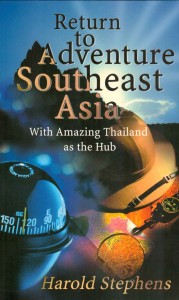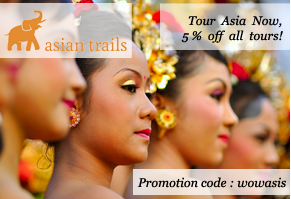 The problem with many adventure travel books is that the layperson can’t easily replicate the travels discussed in them. This is not the case with veteran adventure writer Harold Stephens’ Return to Adventure Southeast Asia, with Amazing Thailand as the Hub (2000, ISBN 0964-2521-6-3). As experienced travelers ourselves, what fascinated us here at WoWasis is how many of these spectacular small adventures are easily doable, and how many we didn’t even know about.
The problem with many adventure travel books is that the layperson can’t easily replicate the travels discussed in them. This is not the case with veteran adventure writer Harold Stephens’ Return to Adventure Southeast Asia, with Amazing Thailand as the Hub (2000, ISBN 0964-2521-6-3). As experienced travelers ourselves, what fascinated us here at WoWasis is how many of these spectacular small adventures are easily doable, and how many we didn’t even know about.
Who knew you could take a two hour train ride out of Bangkok to the town of Mahachai, about which the author says “For those who want to see Thailand in a capsule, this is the train trip to take. It has everything in a nutshell that a long, two-day train can offer.” That’s two hours versus two days! This is just one of the several train trips that Stephens suggests, including one from Bangkok to Singapore that seemed tantalizing.
The author breaks down is adventures into trains, scuba and wreck diving, 4 wheeling, bicycles, spelunking, trekking, yachting and island hopping, mountain climbing and volcanoes, river exploring, and archaeological digs/searching for lost cities. He covers the countries of Thailand, Cambodia, Laos, Malaysia (Borneo and mainland), Indonesia, and India.
 We weren’t aware of three temples in Thailand that appear to be must-sees: Prasat Muang Tam, Prasat Sikhoraphum, and Ban Pluang. And how about the archaeological digs and museum at Ban Chiang? You can see many of these artifacts in Bangkok’s splendid Suan Pakkad Palace museum, but why not go to the source?
We weren’t aware of three temples in Thailand that appear to be must-sees: Prasat Muang Tam, Prasat Sikhoraphum, and Ban Pluang. And how about the archaeological digs and museum at Ban Chiang? You can see many of these artifacts in Bangkok’s splendid Suan Pakkad Palace museum, but why not go to the source?
At 227 pages with a splendid index, the book never ceases to amaze, with Stephens’ romanticism replete throughout the book. Here’s a great example, on Bangkok’s Chao Phraya river:
For more than a year I lived aboard Third Sea [the author’s self-built schooner] on the Chao Phraya, down at the mouth near Samut Prakan. The river here is wide, and I was able to observe life on the river, for every vessel, large and small, entering or leaving Bangkok, had to pass before me. Vessels of every flag from every nation found their way past the gray-stoned Customs and Immigration Building. There were tankers and freighters, flat-bottomed scows and lighters, barges loaded with stone and charcoal,and others with rice, being towed by powerful tugs, river taxis and ferries, sampans being sculled, trim gigs from naval vessels, cruise boats, long long-tail skiffs clipping along at incredible speeds, even great sailing junks with their lug sails pulling hard on the quarter, and, last, the Thai fishing boats, by the thousands, coming and going with the tides, feeding a hungry city with their 400 tons of fish every day, and each boat with its sea-toughened crew, torsos tattooed in enigmatic designs, all waving and laughing.
The best time to feel the mood is early morning. At first light, before dawn, the river is intimate. There is little movement, and one almost feels the presence of others as an intrusion. Blinding colors from a tropical sun have not yet supplanted soft grays, and uncertain forms on distant banks, the silhouette of trees or temple spires, that are harsh by day now loom soft in shades of coolness.
Then through the fog and mist rising up from the river, barges in tow, like elephants holding tails in a circus performance, slowly appear. Soon another string of barges come into sight, and another. A river taxi scurries across the water. A freighter lifts anchor and sounds its whistle. A sampan with sleepy-eyed ladies of the night hastily pulls away from a tanker which is also leaving, and now schoolchildren, all in neat scrubbed uniforms, arrive aboard a river bus. People wave and I have another cup of coffee on the aft deck. The river has come to life, pulsating, vibrant.
By mid-morning, Bangkok shimmers in the heat, and while the city swelters, the children born to the river take over. The wide expanse of brown water becomes their playground. Naked, with the image of innocence, they let themselves be dragged through the water by holding on to passing boats, they dive from piers and docksides, and some, the more daring, leap from the highest bridges into the swift currents below, only to come bobbing up a few feet downstream, their faces aglow with cherubic smiles.
For a book written in 2000, it’s remarkably current (Angkor Wat, for instance, is more accessible now than it was in 2000). The real warning here is that the reader will experience a real sense of wanderlust and predictably start planning a first or return trip to Southeast Asia. With this book, Stephens has made great inroads into making the seemingly inaccessible affordable and doable. Buy this book now at the WoWasis eStore.
I have wanted to travel to Asia, but didn’t know how to do it as a layman. Thank you for the info. I’ll have to get the book. With limited time on my hands, I can now see parts of Asia that I didn’t know would be possible in such a short time.